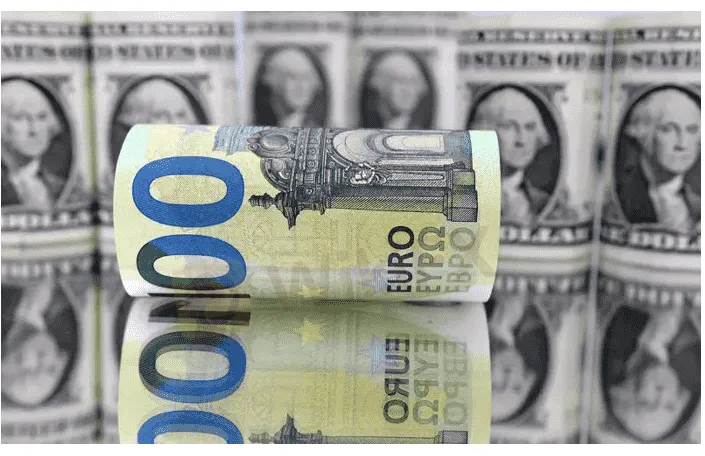简体中文
繁體中文
English
Pусский
日本語
ภาษาไทย
Tiếng Việt
Bahasa Indonesia
Español
हिन्दी
Filippiiniläinen
Français
Deutsch
Português
Türkçe
한국어
العربية
U.S. dollar share of global FX reserves rises in Q2; euro share slips
Abstract:The U.S. dollar’s share of currency reserves reported to the International Monetary Fund rose in the second quarter, with the Federal Reserve in the midst of an aggressive tightening cycle aimed at stamping out uncomfortably high inflation.

The greenbacks share of reserves rose to 59.5%, from 58.8% in the first quarter, IMF data showed on Friday.
The euros share, however, slipped to 19.8% in the second quarter from 20% in the first, declining for three straight quarters.
Global reserves, which are reported in U.S. dollars, are central bank assets held in different currencies used in part to support their liabilities. Central banks sometimes use reserves to help support their respective currencies.
“The new (IMF) figures illustrate the growing demand for the dollar as the Fed embarked on an aggressive tightening cycle which collided with Europes darkening growth outlook,” said Joe Manimbo, senior market analyst, at payments company Convera in Washington.
The dollar index rose 6.5% in the second quarter after advancing 2.4% in the first quarter, underpinned by the Feds policy tightening stance. So far in 2022, the greenback has surged 17% against a basket of major currencies, on track for its best yearly percentage gain.
The Fed, which has raised U.S. borrowing costs faster in 2022 than any time since the 1980s, has raised interest rates to a range of 3.0%-3.25%, from 0% in March. U.S. rate futures have priced in on Friday a 59.3% chance of another 75 basis-point rate increase.
In contrast, the euro zone has been hampered by an energy crisis, which has weighed on the euro even though the European Central Bank has been hiking interest rates as well.
In the second quarter, the euro dropped 5.3% versus the dollar.
The IMF data also showed the Chinese yuan‘s share of currency reserves edged up to 2.9% in the second quarter from 2.8% in the first three months of the year. In absolute terms, however, central bank holdings of the yuan fell 4.1% to $322.38 billion. The IMF started tracking the yuan’s share in 2017.
The yens share dipped to 5.1% during the period, compared with 5.3% in the first quarter. In dollar terms, yen reserves fell 8.3% to $578.52 billion.
IMF data also showed global reserves slid to $12.036 trillion in the second quarter, from $12.544 trillion in the first quarter. In the fourth quarter of 2021, reserves hit a record $12.92 trillion.

Disclaimer:
The views in this article only represent the author's personal views, and do not constitute investment advice on this platform. This platform does not guarantee the accuracy, completeness and timeliness of the information in the article, and will not be liable for any loss caused by the use of or reliance on the information in the article.
Read more

Trade FX-Limited - Scams & Lack of Withdrawals are Normal Here!
Trade FX-Limited adds to the list of forex brokers whose investors have been fed up with a lack of withdrawals, leading to scams later. Check out what customers are saying about this forex broker.

10 Signs of a Fake Forex Trading or Crypto Website
Been to a forex trading or crypto website promising guaranteed returns, displaying too good to be true testimonials and far too many impressive features? Beware, it's a SCAM! In this article, we discuss 10 signs of a fake forex trading or cryptocurrency website.

CySEC issued warning over 10 Unlicensed firms
The Cyprus Securities and Exchange Commission (CySEC) has issued a warning against over 10 investment firms operating without proper authorization. These firms are not licensed to provide financial services and may pose serious risks to investors. CySEC advises the public to avoid dealing with unregulated entities

Know the Red Flags before Investing in Primarkets
Knowing the red flags of FX Broker is the most important act while you are thinking to invest your money in the Forex market and are enthusiastic about Forex trading.
WikiFX Broker
Latest News
XTB Hack 2025: Major Security Breach Exposes Client Accounts
These are America's 10 weakest state economies most at risk in a recession
These are America's 10 strongest state economies best prepared for a recession
Federal Reserve quietly responds to Trump administration attacks over renovation
Tariff Windfall Drives Surprise $27 Billion US Budget Surplus In June
Top Wall Street analysts are upbeat about these dividend-paying stocks
Singapore's economy grows 4.3% in second quarter, beating expectations
What WikiFX Found When It Looked Into Emar Markets
MT4 vs MT5 Which Forex Trading Platform Fits Your Needs in 2025?
Stock futures slide on more Trump tariff letters, but are off worst levels of session: Live updates
Currency Calculator


